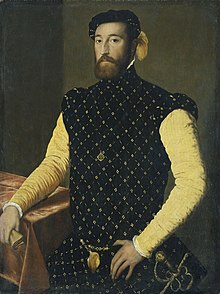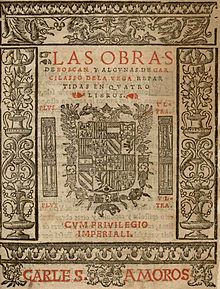Garcilaso de la Vega (poet)
Garcilaso de la Vega | |
|---|---|
 Portrait at the New Gallery, Kassel | |
| Born | García Laso de la Vega 15 February 1498–1503 Toledo, Castile (present-day Spain) |
| Died | 14 October 1536 (aged 33–38) Nice, Duchy of Savoy (present-day France) |
Garcilaso de la Vega,
Biography
Garcilaso was born in the Spanish city of
Garcilaso was the second son which meant he did not receive the mayorazgo (entitlement) to his father's estate. However, he spent his younger years receiving an extensive education, mastered five languages (
. When his father died in 1509, Garcilaso received a sizeable inheritance.
After his schooling, he joined the military in hopes of joining the royal guard. He was named "contino" (imperial guard) of Charles V in 1520, and he was made a member of the Order of Santiago in 1523.
There were a few women in the life of this poet. His first lover was Guiomar Carrillo, with whom he had a child. He had another suspected lover named
Garcilaso's military career meant that he took part in the numerous battles and campaigns conducted by Charles V across Europe. His duties took him to
Works
Garcilaso de la Vega is best known for his tragic love poetry that contrasts the playful poetry of his predecessors. He seemed to progress through three distinct episodes of his life which are reflected in his works. During his Spanish period, he wrote the majority of his eight-syllable poems; during his Italian or
Throughout his life, Garcilaso de la Vega wrote various poems in each of these types. His works include: forty Sonetos (Sonnets), five Canciones (Songs), eight Coplas (Couplets), three Églogas (Eclogues), two Elegías (Elegies), and the Epístola a Boscán (Letter to Boscán). Allusions to classical myths and Greco-Latin figures, great musicality, alliteration, rhythm and an absence of religion characterize his poetry. It can be said that Spanish poetry was never the same after Garcilaso de la Vega. His works have influenced the majority of subsequent Spanish poets, including other major authors of the period like
For example: (égloga Tercera):
- Más a las veces son mejor oídos
- el puro ingenio y lengua casi muda,
- testigos limpios de ánimo inocente,
- que la curiosidad del elocuente.
He was very good at transmitting the sense of life into writing, in many poems including his «dolorido sentir»:
- No me podrán quitar el dolorido
- sentir, si ya del todo
- primero no me quitan el sentido.
We see the shift in traditional belief of Heaven as influenced by the Renaissance, which is called "neo-Platonism," which tried to lift love to a spiritual, idealistic plane, as compared to the traditional Catholic view of Heaven. (Égloga primera):
- Contigo mano a mano
- busquemos otros prados y otros ríos,
- otros valles floridos y sombríos,
- donde descanse, y siempre pueda verte
- ante los ojos míos,
- sin miedo y sobresalto de perderte. (Égloga primera)
He has enjoyed a revival of influence among 21st century pastoral poets such as Seamus Heaney, Dennis Nurkse, and Giannina Braschi.
Literary references

Garcilaso is mentioned in multiple works by Miguel de Cervantes. In the second volume of Don Quixote, the protagonist quotes one of the poet's sonnets.[7] In El licenciado Vidriera, Tomás Rodaja carries a volume of Garcilaso on his journey across Europe.
The title of Pedro Salinas's sequence of poems La voz a ti debida is taken from Garcilaso's third eclogue.
In the novel Of Love and Other Demons by Gabriel García Márquez, one of the main characters, Father Cayetano Delaura, is an admirer of Garcilaso de la Vega. In the novel, which takes place in 18th-century colonial Colombia, Delaura is forced to give up being a priest because of his tragic love affair.
Puerto Rican poet Giannina Braschi wrote both a poetic treatise on Garcilaso de la Vega's Eclogues, as well as a book of poems in homage to the Spanish master, entitled Empire of Dreams.
Modern translations
- The Odes and Sonnets of Garcilaso de la Vega, trans James Cleugh, (London: Aquila, 1930)
Further reading
- Creel, Bryant. "Garcilaso de la Vega". Dictionary of Literary Biography, Volume 318: Sixteenth-Century Spanish Writers. A Bruccoli Clark Layman Book. Edited by Gregory B. Kaplan, University of Tennessee. Gale, 2005. pp. 62–82.
- Braschi, Giannina. “La metamorfosis del ingenio en la Egloga III de Garcilaso." Revista Canadiense de Estudios Hispanicos, 4.1, 1979.
References
- ISBN 9788416023776.
- ISSN 0247-381X.
- ^ "Garcilaso de la Vega" (PDF). Consellería de Cultura, Educación e Ordenación Universitaria (in Spanish). Xunta de Galicia. Retrieved 10 August 2018.
- Universidad de Sevilla: 113–164.)
{{cite journal}}: Cite journal requires|journal=(help - JSTOR 43398752.
- ^ Darst, David H. (1979). "Garcilaso´s Love for Isabel Freire: The Creation of a Myth". Journal of Hispanic Philology. 3: 261–268.
- ^ Herreid, Grant. "The Musical World of Don Quixote" (PDF). Archived from the original (PDF) on October 17, 2017. Retrieved October 16, 2017.
External links
- Works by Garcilaso de la Vega at Project Gutenberg
- Works by or about Garcilaso de la Vega at Internet Archive
- Works by Garcilaso de la Vega at LibriVox (public domain audiobooks)

- Page about Garcilaso de la Vega "La Página de Garcilaso en Internet." 2006. La Asociación de Amigos de Garcilaso de la Vega (Toledo, España). (in Spanish)
- "Multiculturalism Gone Wrong: Spain in the Renaissance", Alix Ingber, (adapted from a lecture). <http://www.dean.sbc.edu/ingber.html>. [Last updated: January 19, 1998].
- "Spanish Literature (Archived 2009-11-01)," Microsoft Encarta Online Encyclopedia 2006.
